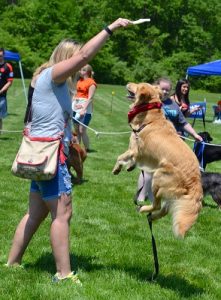 Just like there is no one type of dog, there is no one type of dog training method. Rather, there are multiple methods, each with pros and cons, sometimes hotly disputed. Often, a combination of training methods might be used. In this article, we will cover the two most well-known forms of training: Positive Reinforcement Training, and Alpha Dog or Dominance Training.
Just like there is no one type of dog, there is no one type of dog training method. Rather, there are multiple methods, each with pros and cons, sometimes hotly disputed. Often, a combination of training methods might be used. In this article, we will cover the two most well-known forms of training: Positive Reinforcement Training, and Alpha Dog or Dominance Training.
Positive Reinforcement Training
In positive reinforcement training, your dog is rewarded for good behavior with treats and praise. Word or hand gestures are used to request the desired behavior (sit, down, off, etc.) and the reward is provided within seconds of completing the behavior successfully, so that the dog learns to associate that behavior with a reward. Sometimes a clicking device is used as the treat is given to provide an auditory cue as well. This is known as “clicker training.”
With this type of training, bad behavior is primarily ignored. The idea is to reward the behavior you want, not punish the behavior you do not want. For example, if you want to deter your dog from jumping on you, the response might be to turn your back and ignore them, and then reward the dog when they stop jumping.
Positive reinforcement training requires consistency and diligence and can feel like a lot of effort. However, it tends to be very effective, and once desired behaviors are learned, they are more easily maintained over time. Positive reinforcement training also provides a bonding experience between owner and dog, which is beneficial for all dogs, but particularly those who are more anxious.
Alpha Dog / Dominance Training
Alpha dog or dominance training is based on the concept that dogs have a pack mentality in which there is a social hierarchy. This training method, made popular by Cesar Milan on National Geographic Channel’s Dog Whisperer, teaches that the dog must learn that their owner is the alpha, or leader of the pack. For example, the owner does everything first, such as entering a room or eating. Dogs are discouraged from getting on the furniture or sleeping on the bed. Trainer’s tools might be choke chains, prong collars or electric collars, used to “correct” a dog. Training may also involve saying “no” in a stern voice or physically moving or placing the dog.
Dominance training requires consistency over the long term with the owner acting in the alpha role. Although it may curb unwanted behavior, some believe this may be due to a fear response, which can increase your dog’s anxiety level and negatively impact the bond between dog and owner.
These are just the two most well-known training methods. The important thing is that you find a trainer who has a training method that you feel comfortable with and are willing to work on. Training should be a life-long partnership between you and your dog.
